Lea Wait's Blog, page 11
June 30, 2025
Cover Copy—Can You Help?
Kaitlyn Dunnett/Kathy Lynn Emerson here, today asking for some feedback from those who read the Maine Crime Writers’ blog.
I’ve written twice before about the 1993 historical romance I’ve been completely rewriting to shift the focus to the heroine’s journey. You can read those here and here if you’re interested. Finally, Treacherous Visions is just about ready to launch. Only one more proofread (I hope!) to go. Well, that and writing the promo/cover copy and designing the cover.
That’s where I could use some help. The basic book description isn’t a problem. Here’s what it will probably say:
In today’s world, she would be called psychic, or a channeler, or perhaps a person with a gift. In the first half of the seventeenth century there were other names for such people—words like witch and sorcerer.
On the surface, Mercy Browne seems like an ordinary young Englishwoman, but she has known since childhood that she must keep secret the fact that she has disturbing visions. That they always involve violence and death is bad enough, but when she is in the thrall of one, she enters a trancelike state. Every vision throws her into treacherous waters, for if the wrong person notices her odd behavior, in England or in the New World, she will be in mortal danger.
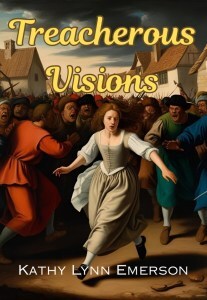
Just for grins, this is what AI came up with from a description
In the case of most books, cover copy also includes blurbs—quotes from other authors or from reviews of the author’s previous work in reputable review journals like Publishers Weekly, Booklist, Library Journal, or (in the case of historical novels) Historical Novels Review.
Therein lies the problem. I already have plenty of potential quotes, but I am not sure which ones to use. Further, I am not sure it’s fair to readers to use quotes that don’t apply to this specific book, even if I specify what book they do refer to. Yes, I could ask writer friends to read the new version and blurb it, but that route has, frankly, always bothered me. Of course my friends are going to say nice things about it. And I’m not at all convinced that readers think another writer’s opinion of a work is all that important anyhow, at least not compared to the opinion of a professional, unbiased reviewer.
What do you think? I’d really appreciate your comments, especially in relation to the sampling of quotes I’m including below.
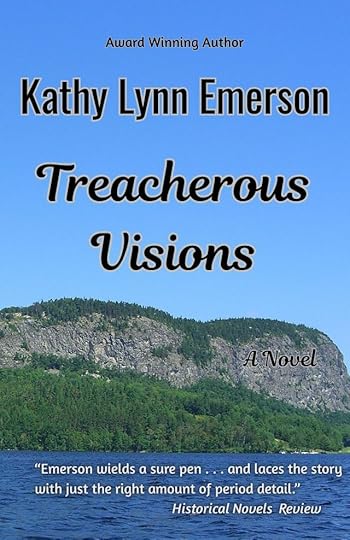
current front runner for cover with review quote
Reviews of original 1993 version, which had a different title, different character names, started in what is now Chapter Six, and was 24,000 words longer than the present book:
“a unique, action-packed, well-written supernatural historical . . . an exciting novel that readers will want to finish in one sitting.” The Talisman
“Vivid.” RT
An “enchanting tale.” Maine in Print
Reviews of other historical novels I’ve written:
“Rich and lushly detailed, teeming with passion and intrigue, this is a novel in which you can happily immerse yourself in another time and place.” RT on The Pleasure Palace
“Emerson skillfully crafts a strong heroine.” Publishers Weekly on Between Two Queens
“A solid historical with a refreshingly willful, sexually liberated heroine.” Publishers Weekly on By Royal Decree
“A first-rate read.” Booklist on By Royal Decree
“Emerson has written a wonderfully absorbing novel that . . . beautifully depicts the difficulty of living in a treacherous period.” Library Journal on At the King’s Pleasure
“Gifted author Kate Emerson crafts a fascinating novel by weaving historical facts into a winning piece of fiction.” Single Titles on Royal Inheritance

alternate cover background (it’s a boulder in the woods)
So, to reiterate my questions:
Is it cheating to use review quotes from the earlier version?
Is it better to use quotes about other historical novels I’ve written (clearly identified) even though none of them involve paranormal elements?
Has a blurb from a well-known writer or a writer you like ever persuaded you to try a book by someone you’ve never heard of?
Do “customer reviews” such as those at Amazon or on Goodreads make effective blurbs?
Thanks in advance, everyone, and feel free to chime in on cover art as well.
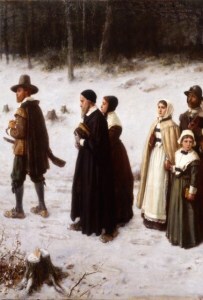
also an alternative, but probably not enough white space for text
Kathy Lynn Emerson/Kaitlyn Dunnett has had sixty-four books traditionally published and has self published others. She won the Agatha Award and was an Anthony and Macavity finalist for best mystery nonfiction of 2008 for How to Write Killer Historical Mysteries and was an Agatha Award finalist in 2015 in the best mystery short story category. In 2023 she won the Lea Wait Award for “excellence and achievement” from the Maine Writers and Publishers Alliance. She was the Malice Domestic Guest of Honor in 2014. She is currently working on creating new editions of her backlist titles. Her website is www.KathyLynnEmerson.com.
The Unsolved Murder of Dorothy Milliken
 From time to time, we introduce you, our readers, with a new Maine author. Today we’re excited to share a blog from Sharon Kitchens about her new true crime, The Murder of Dorothy Milliken.
From time to time, we introduce you, our readers, with a new Maine author. Today we’re excited to share a blog from Sharon Kitchens about her new true crime, The Murder of Dorothy Milliken.
Sharon Kitchens: When my editor first asked me if I’d consider writing a true crime book, I told him absolutely not. The genre, to me, felt macabre—a space more focused on the lurid details than the real people left behind. Yet, the morning after the call, I found myself settling into my favorite reading chair and pulling up the Maine State Police’s Unsolved Homicides webpage. A few clicks in, and I was reading about Dorothy Milliken, a woman found lying outside a laundromat in Lewiston at 4:45 a.m. on a cold November morning in 1976.
She had left home around 11 p.m., I read, something she often did—laundry was a late-night ritual for her. That detail made me pause. There was something so intimate, so vulnerable, about a woman alone in the quiet hours doing something as ordinary as washing clothes. I started scribbling lines of questions in a notebook.
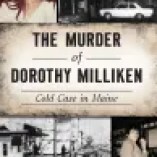 Not long after, I reached out to a couple of people I know—both former detectives—asking them if I was completely out of my mind for thinking I might write this story. They told me I wasn’t and that I should—that I could bring attention to the case. One offered to connect me with a sergeant at the Maine State Police. That was the turning point. I met with the detective currently assigned to the case and then with Dorothy’s daughter, Tonia. In both meetings, I told them the same thing: I’ll walk away if you want. I wasn’t there to promise closure. I was there to listen.
Not long after, I reached out to a couple of people I know—both former detectives—asking them if I was completely out of my mind for thinking I might write this story. They told me I wasn’t and that I should—that I could bring attention to the case. One offered to connect me with a sergeant at the Maine State Police. That was the turning point. I met with the detective currently assigned to the case and then with Dorothy’s daughter, Tonia. In both meetings, I told them the same thing: I’ll walk away if you want. I wasn’t there to promise closure. I was there to listen.
Because for me, Dorothy is the story. She’s a full person, not just the victim of a violent act.  A woman who lived, who loved, who people missed.
A woman who lived, who loved, who people missed.
Throughout my research, I tried to be responsible. I hope I was. Every meeting I set up and every call or text I made, I was asking people to relive what may be the worst day of their life. Because details matter. The brand of cigarettes she smoked. The length of a high school senior class trip. The color of a shirt. These are the things loved ones hold onto. And when the press gets them wrong, the pain is real.
True crime, if done carelessly, can retraumatize people. My hope with this book was to tell Dorothy’s story with her family. With the understanding that these are real people and what happened to them decades ago still traumatizes them today.
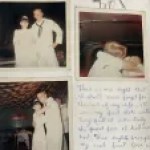 There were limits, of course. Many of the original investigators had died or drifted into quiet retirement by the time I started asking questions. But remarkably, nearly four dozen people—friends, relatives, experts, classmates, neighbors, and former law enforcement—answered my emails and calls. Some opened doors I didn’t even know to knock on. Others helped me drag information previously hidden away into the light.
There were limits, of course. Many of the original investigators had died or drifted into quiet retirement by the time I started asking questions. But remarkably, nearly four dozen people—friends, relatives, experts, classmates, neighbors, and former law enforcement—answered my emails and calls. Some opened doors I didn’t even know to knock on. Others helped me drag information previously hidden away into the light.
 The Office of the Maine Attorney General and the Maine State Police would not allow me access to case files—even those of closed cases. They weren’t prepared for how far I would dig—or how much I’d find about what had been overlooked or pushed aside. That was deeply frustrating. But I got the chance to know Dorothy and the people who loved her. What I found wasn’t a cautionary tale or a cold case cliché—but a woman who adored her children, made people laugh, and gave more than she took. She loved Ringo Starr, had a sharp eye for fashion, and could drink coffee like a prizefighter—black, no sugar, no cream. She wasn’t just a headline. She was a total badass, really.
The Office of the Maine Attorney General and the Maine State Police would not allow me access to case files—even those of closed cases. They weren’t prepared for how far I would dig—or how much I’d find about what had been overlooked or pushed aside. That was deeply frustrating. But I got the chance to know Dorothy and the people who loved her. What I found wasn’t a cautionary tale or a cold case cliché—but a woman who adored her children, made people laugh, and gave more than she took. She loved Ringo Starr, had a sharp eye for fashion, and could drink coffee like a prizefighter—black, no sugar, no cream. She wasn’t just a headline. She was a total badass, really.
Sharon Kitchens has lived in Maine for over two decades. Her debut, Stephen King’s Maine: A History & Guide (Arcadia Publishing, 2024), a Maine bestseller, is an oral history rooted in the real towns behind King’s fictional landscape—endorsed by King himself: “This book by Sharon Kitchens is really interesting. Not all of it is right, but most of it is.” Her second book, The Murder of Dorothy Milliken, Cold Case in Maine (Arcadia Publishing, 2025) is a meticulously researched account of a nearly half-century-old unsolved homicide. Publishers Weekly called it a “complex, ethical retelling of a life ended far too soon.” Sharon is currently querying agents for her next project—a cultural study of Stephen King’s female characters. She’s a regular at her local library and cafés, where she’s usually found with a stack of books and a lavender latte. Her fondness for Patti Smith’s poetry is matched only by her love of Taylor Swift’s lyrics. She is a cat and dog person.
June 27, 2025
Weekend Update: June 28-29, 2025
 Next week at Maine Crime Writers there will be posts by special guest Sharon Kitchens (Monday), Kaitlyn Dunnett/ Kathy Lynn Emerson (Tuesday), and Kate Flora (Thursday), and Friday we are taking the day off to celebrate the 4th of July.
Next week at Maine Crime Writers there will be posts by special guest Sharon Kitchens (Monday), Kaitlyn Dunnett/ Kathy Lynn Emerson (Tuesday), and Kate Flora (Thursday), and Friday we are taking the day off to celebrate the 4th of July.
In the news department, here’s what’s happening with some of us who blog regularly at Maine Crime Writers:
An invitation to readers of this blog: Do you have news relating to Maine, Crime, or Writing? We’d love to hear from you. Just comment below to share.
And a reminder: If your library, school, or organization is looking for a speaker, we are often available to talk about the writing process, research, where we get our ideas, and other mysteries of the business, along with the very popular “Making a Mystery” with audience participation, and “Casting Call: How We Staff Our Mysteries.” We also do programs on Zoom. Contact Kate Flora
June 26, 2025
Summer Reruns . . My Father’s Grin
Spending a lot of summer time decluttering lately and reminded myself of this piece that came from a challenge prompted by Tim O’Brien’s The Things They Carried. A rerun from 2016.
Like all people who love their work, I seek to establish an integrity in it, to make what I love to do and what I have to do one and the same. And like all superstitious beings, I need amulets to add magic to what conscious effort and thought can make possible. The largest of these charms is the writing desk I carried home from Oregon, built from red madrona wood. It is the field for the other things that carry me to work:
My father’s grin
On the back left corner of my desk sits a photo of my father. He stands in a small boat off Cape Cod, holding up a very small bluefish he’s caught on a fly rod, his first ever. 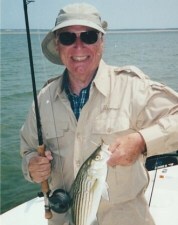 He’s 72 years old and the grin under his sun hat is as goofy and beatific as a boy on his first bike. This photograph reminds me there is no more blessed attitude than that of the amateur, the person who works for love. It tells me to take on things for no other reason than love, the love of something new, the chance to try something you don’t already know how to do. My father’s grin reminds me that while mastery is potent, a wide and seeking love is more so. He reminds me that each task has intrinsic value, and to accept the grace in that.
He’s 72 years old and the grin under his sun hat is as goofy and beatific as a boy on his first bike. This photograph reminds me there is no more blessed attitude than that of the amateur, the person who works for love. It tells me to take on things for no other reason than love, the love of something new, the chance to try something you don’t already know how to do. My father’s grin reminds me that while mastery is potent, a wide and seeking love is more so. He reminds me that each task has intrinsic value, and to accept the grace in that.
My mother’s quilt
On the wall in front of my desk hangs a red and white flying-goose pattern quilt my mother sewed for my wife and me. A daughter of the Depression, she still finds it difficult to believe in the abundance of this world, though all her generosities – unspoken and (by her preference) unattributed, bely that part of her history. The quilt and quilter sit with me every day to remind me that, even when I feel I have no more resources, when I feel most poor, I can always afford to give something away through my work. And that will make me better.
My grandfather’s knife
In the right-hand drawer of the madrona desk sits my grandfather’s pocket knife with the black bone handle and deer-horn ends. I forever see him using it to dig out the compacted roots of shrubs he’s transplanting, to cut the fleshy stems of roses for grafts, or to lop a length of string to tie a bunch of newspapers. I use it in the ways he used it, and for sharpening pencils and peeling apples beside, and to remember that, with patience and effort, the most difficult work breaks down into single, simple tasks. Often it’s the simple tools we require, despite what we think, or wish.
Some rocks
For paperweights, I use the rocks I’ve brought from places I’ve fished, each with a hand-painted legend telling me how I did: “Umpqua River, many shad;” “Deschutes, stuck 2 , landed 1.”  Aids to memory, they carry the freight of friends and rivers and time spent in the one church I recognize, the outdoors. My rocks remind me that work and leisure do not conflict but complement, and when I try to bull on through a piece instead of trying to flow with it, I don’t do my best work.
Aids to memory, they carry the freight of friends and rivers and time spent in the one church I recognize, the outdoors. My rocks remind me that work and leisure do not conflict but complement, and when I try to bull on through a piece instead of trying to flow with it, I don’t do my best work.
A grandmother’s smirk
One more photograph sits on the desk: my wife’s grandmother celebrating her 93d birthday, her tongue stuck out at the camera. This woman who never dressed in a color but purple and refused the Boston Post Cane when it was offered her (not wanting to be identified as the oldest resident in town) was a devoted Red Sox fan, thus patron of lost causes. (Sadly, she died before 2004). She and her daughter-in-law’s mother listened to games together in their separate houses, the party line open between them for commentary. Her presence in my work place reminds me that too much seriousness is poison, that I need to allow myself to be joyful and loose, however I can manage – I need to take chances with my dignity.
Meditating Mary
Last on the desk sits a white cast resin statue of the Virgin Mary meditating in the lotus position, the original sculpted by my friend Matt Lyon.  Matt, the only Buddhist monk I’ve ever drunk Guinness with, died when he laid down his motorcycle in front of a car that ran a Stop sign. Knowing he would likely die, his last impulse was to keep the long line of vehicles behind him from piling up, causing more casualties than his own. Matt’s Mary reminds me to surrender myself once in a while, not hold myself or my work so important it can’t be sacrificed for something larger. And it tells me the intention of a prayer is far more important than the form.
Matt, the only Buddhist monk I’ve ever drunk Guinness with, died when he laid down his motorcycle in front of a car that ran a Stop sign. Knowing he would likely die, his last impulse was to keep the long line of vehicles behind him from piling up, causing more casualties than his own. Matt’s Mary reminds me to surrender myself once in a while, not hold myself or my work so important it can’t be sacrificed for something larger. And it tells me the intention of a prayer is far more important than the form.
David Mamet said once in an interview: “Being a writer is so ethereal that I think most of us tend to surround ourselves with tchotchkes so we can actually be sure we have a past.”
“Tchotchkes” is too flippant a name for my charms – that might leach their magic – but I understand what he says. The items we travel with choose our various pasts, our presents and futures. And even when I do not see myself whole in my work, I trust my amulets to push me every day. This is what I strive for: a place where my love for the work and my need to do it are united, the place where the things that carry me abide.
The Summer I became a Writer
There are two questions often asked of writers. The first, where do your ideas come from? The second, when did you know you wanted to write? My dad, and one very magical summer, serves as my reply.
We learned cursive writing in third grade. The summer between third and fourth grade, my parents bought me a Girl Scout branded diary. I was thrilled, and I resolved to write something exciting every night. I’d already worked my way through the Nancy Drew book series, so I was pretty sure I knew what to look for. I was going to solve mysteries. Not just mysteries, murder mysteries. My dad was all in from day one. He didn’t know about the murder part of the mystery stuff, but he promised me a fun summer of excitement. He didn’t disappoint.

L. Nederwimmeron via Pixabay.
The greater New Jersey/New York area was fertile ground for a kid with an imagination. First stop was the Empire State Building. The view from the observation deck was outstanding. This was 1961 so it was still the tallest building in the world. Dad told me about planes flying into it during the War and calmly explained that a penny tossed from that height would go right through the person it hit. My internal writer cackled with glee. Through viewfinders from the observation deck, you could see the Statue of Liberty. The next weekend stop on our summer tour.

Maurice LeBail via Pixabay
The hike to the crown of the Statue of Liberty is arduous. Visitors climb a metalwork spiral staircase to the top. The rails had spaces between them that were large enough for someone to slip through and low enough to flip over. My bloodthirsty mind filled in the blanks with a vicious chase, resulting in someone going over the top. I even visualized them getting stuck on one of the support beams between the statue and the stairs. Dad had a special surprise for me when we reached the crown. He had a friend whose son was a member of the park police. He took us into the long-closed torch. No stairs there. Visitors (only park police since 1916) climb a rickety ladder to a tiny observation platform surrounded by a low rail. The torch was closed to the public after an explosion at the Black Tom Munitions plant damaged it. An early act of terrorism.
 We spent the rest of the summer visiting the local amusement parks. Palisades, Freedomland, and the Jersey Shore until it was time to make our annual trip to visit family in Florida. I no longer have the journal, but the memories are as fresh today as they were then. That’s the summer I knew I wanted to be a writer, and discovered that the best inspiration comes from life.
We spent the rest of the summer visiting the local amusement parks. Palisades, Freedomland, and the Jersey Shore until it was time to make our annual trip to visit family in Florida. I no longer have the journal, but the memories are as fresh today as they were then. That’s the summer I knew I wanted to be a writer, and discovered that the best inspiration comes from life.
What about you, readers and writers. Can you pinpoint a moment in time when you knew what you would become?
June 24, 2025
My New Web Page Is Live!
My long-awaited website is now live! Take a few minutes to check it out and let me know what you think…
June 20, 2025
Weekend Update: June 21-22, 2025
 Next week at Maine Crime Writers there will be posts by Maureen Milliken (Monday), Sandra Neily (Tuesday), Kait Carson (Thursday), and Dick Cass (Friday).
Next week at Maine Crime Writers there will be posts by Maureen Milliken (Monday), Sandra Neily (Tuesday), Kait Carson (Thursday), and Dick Cass (Friday).
In the news department, here’s what’s happening with some of us who blog regularly at Maine Crime Writers:
Matt Cost will be signing books at Shermans Maine Coast Book Shop in Topsham today, 6/21/25, from noon to 3 p.m. The emphasis will be on his latest release, The Not So Merry Adventures of Max Creed, as will be the following COST TALKS.
On Sunday, 6/22/25, he will doing a COST TALK at the Dr. Shaw Memorial Library in Mt. Vernon at 2 p.m.
On Tuesday, 6/24/25, he will be doing a COST TALK at the Norway Memorial Library in Norway at 6:30 p.m.
On Thursday, 6/26/25, he will be doing a COST TALK at the Farmington Public Library in Farmington at 6 p.m.
On Friday, 6/27/25, he will be doing a COST TALK at the Fryeburg Public Library in Fryeburg at 3 p.m.
An invitation to readers of this blog: Do you have news relating to Maine, Crime, or Writing? We’d love to hear from you. Just comment below to share.
And a reminder: If your library, school, or organization is looking for a speaker, we are often available to talk about the writing process, research, where we get our ideas, and other mysteries of the business, along with the very popular “Making a Mystery” with audience participation, and “Casting Call: How We Staff Our Mysteries.” We also do programs on Zoom. Contact Kate Flora
The Little Things by Matt Cost
The life of a writer can be a hard road to travel. Lonely isolation with your only company being your own reflection in the computer screen staring back at you. Taking and accepting the criticism of editorial feedback. The anxiety of waiting for early reviews. The sting of haters taking cheap shots at your book. Throwing your book into an ocean of other competing novels. Poor turnouts for speaking and signing events.
And then we do it all over again.
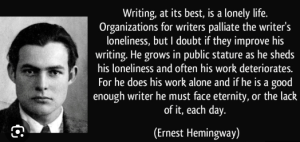
Why?
The love of creation, sure, but it is also the little things that can make all the difference.
Inspiration comes at odd times. For me, it is often on a dog walk in the woods. Just me and my editorial team of dog, Whimzi, Peanut, and Saint. This is where we brainstorm the next plot twist, the road to be taken, and where the characters will take us. And sometimes, just sometimes, that revelation is enormous and makes all my senses tingle in anticipation of getting back to my laptop to get it down on the proverbial paper.

The love of the writing community as a whole is no little thing. But when a fellow author such as Jule Selbo gives your book advance praise, it makes it all worthwhile. “The author weaves a slippery spiderweb of clues and connections for Creed as he plays an assumed role within a vast and dangerous criminal empire. Readers will root for Creed, for he refuses to accept that there is one set of laws for the ordinary people and another set for the ultra-rich scions of industry.”
It is also nice to open your email to see an advance teaser of an upcoming review by Midwest Book Review. “Not always merry but always delightfully unexpected, Max’s ability to confront a wide cast of characters is as astute as his ability to confront his own failings and responses.”
Lit Legend author friend reviews and fabled Midwest Book Reviews are wondrous but sometimes a review from a stranger in the wild is the spark that keeps the journey alive. “With razor-sharp wit and unflinching honesty, Cost crafts a narrative that is as thought-provoking as it is entertaining.” Thank you, Laura Jensen.
I recently did a COST TALK at the Skowhegan Public Library to a low turnout of people (who were a fantastic few by the way). The librarian made a point of telling me that my books are vastly popular and rarely stay on the shelf. She went so far as to show me that the library has all seventeen of my books and only three were currently in. That was uplifting and made a difference.
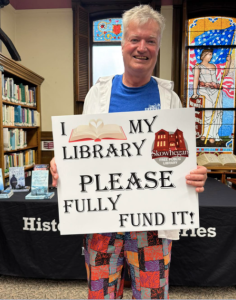
Of course, when the turnout is large, that is pretty dang nice as well.
Another library event on the sole sunny day in some time brought about the dreaded zero attendance. The young man who worked in the library told me that his high school English teacher assigned my first mystery, Mainely Power, to the class, and that they discussed and had to write an essay about the book. Wow. That made the drive and the empty seats all worthwhile.
When I arrived at the Barnes & Noble in South Portland set up by my author friend, Dale Phillips, there were two women who’d driven two hours from Belfast, Maine, because they’d seen that I was signing books that day. They each purchased and had me sign seven books. Nice. The rest of the signing was cake after that.
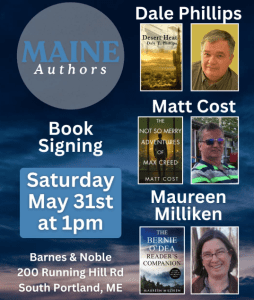 And most recently, I had a table at Brunswick 2nd Friday Art Walk next to author lit legends, Maine Literary Award winners for Crime Fiction—Kate Flora and Maureen Milliken. Friends stopped by to buy books and chat about this and that. Strangers became excited by my collection while others commented that they’d bought, read, and liked my books. One person breathlessly told me she was currently reading Mainely Fear and couldn’t believe she was meeting me.
And most recently, I had a table at Brunswick 2nd Friday Art Walk next to author lit legends, Maine Literary Award winners for Crime Fiction—Kate Flora and Maureen Milliken. Friends stopped by to buy books and chat about this and that. Strangers became excited by my collection while others commented that they’d bought, read, and liked my books. One person breathlessly told me she was currently reading Mainely Fear and couldn’t believe she was meeting me.
In three words? All worth it.
About the Author
Matt Cost was a history major at Trinity College. He owned a mystery bookstore, a video store, and a gym, before serving a ten-year sentence as a junior high school teacher. In 2014 he was released and began writing. And that’s what he does. He writes histories and mysteries.
Cost has published six books in the Mainely Mystery series, starting with Mainely Power. He has also published five books in the Clay Wolfe Trap series, starting with Wolfe Trap. And finally, there are two books in the Brooklyn 8 Ballo series, starting with Velma Gone Awry. For historical novels, Cost has published At Every Hazard and its sequel, Love in a Time of Hate, as well as I am Cuba. The Not So Merry Adventures of Max Creed is his 17th published book.
Cost now lives in Brunswick, Maine, with his wife, Harper. There are four grown children: Brittany, Pearson, Miranda, and Ryan. They have been replaced in the home with four dogs. Cost now spends his days at the computer, writing.
June 19, 2025
Those Who Choose Evil
Kate Flora: In general, when I blog here, I try to talk about more general aspects of writing or being a writer, (or living in Maine) rather than focusing on my own books. Although I will sometimes use my books as examples of points I’m trying to make or illustrations of my thirty year writing journey.
 Today, my focus is specifically on my upcoming book, Those Who Choose Evil, book nine in my Joe Burgess police procedural series. And on writing those Joe Burgess books. The writer’s journey is fascinating to me. I never know what I’ll be called to write, or what discoveries I’ll make about myself, the craft of writing, or my characters along the way. A reader once asked me what I wanted her to take away from the book. Entertainment, of course. The endlessly fascinating questions that arise about good and evil. And often, I don’t know the answer until the book is done. This is a book about parents and children. Good and bad. And about those who chose evil for their lives.
Today, my focus is specifically on my upcoming book, Those Who Choose Evil, book nine in my Joe Burgess police procedural series. And on writing those Joe Burgess books. The writer’s journey is fascinating to me. I never know what I’ll be called to write, or what discoveries I’ll make about myself, the craft of writing, or my characters along the way. A reader once asked me what I wanted her to take away from the book. Entertainment, of course. The endlessly fascinating questions that arise about good and evil. And often, I don’t know the answer until the book is done. This is a book about parents and children. Good and bad. And about those who chose evil for their lives.
For this book, also, it was a continuation of the bond my three detectives have as their lives change and they are impacted by the cases they solve. It was a story that drew in Burgess’s family—the one he thought he’d never have. It called on his newly adopted “crime scene” dog to help when one of his children was in trouble. And it explored the complex relationships between public safety agencies. It also explored the nature of people who don’t want their criminal activities revealed, the nature of parent/child relationships and how some parents can abuse them, and the lengths people will go to to protect themselves, their wealth, and their reputations.
Thinking about reading it? Prepare for another breathless adventure through the cities and forests of Maine.
The book almost didn’t happen.
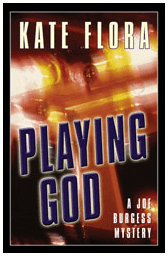
The Joe Burgess series begins with Playing God
As some readers may know, my original plan for the series was to write four books, a quartet that spanned the year’s four seasons. Playing God, the first book, begins on an icy February night.
The small black dog skittered into the street, shining eyes registering canine astonishment that a vehicle dared to be out at this hour. Burgess stomped on the brakes, the Explorer responding with orgasmic ABS shudders, stopping just short of the beast. Four-wheel drive beating out four-foot traction. With a look Burgess decided to take as gratitude, the dog turned and trotted away. A good result. The cops waiting with the body wouldn’t have taken kindly to freezing their nuts off while their detective worked a dead dog scene.
Book two, The Angel of Knowlton Park, begins on a hot July morning:
The fat, blue-black fly circled lazily in the July heat before landing in the child’s open eye. 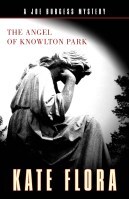 Burgess stifled his instinctive impulse to brush it away. He’d just started working this scene, and he wasn’t letting anything muck up his chances of learning everything it had to say about what had happened to this small dead boy.
Burgess stifled his instinctive impulse to brush it away. He’d just started working this scene, and he wasn’t letting anything muck up his chances of learning everything it had to say about what had happened to this small dead boy.
Book three, Redemption, begins on a clear blue October day:
The two boys on the curb shot out into the street so abruptly Burgess had to stand on the brakes to avoid hitting them. It was seven a.m. Saturday. Columbus Day weekend. The weather was perfect. The city was quiet. And even as he rocked to a stop, shoved the truck into park, and rolled down the window, he knew from the wild look on the taller boy’s face and the single gasped word, “body,” that his day, and probably his weekend, was lost.
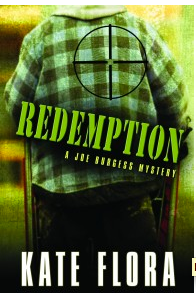
And book four, And Grant You Peace, the planned conclusion of the quartet, takes place in the spring.
Most people run away from fires; firemen and cops run toward them, especially when someone is screaming.
Joe Burgess was sitting in his car, window down to catch the soft spring air, not ready to face the chaos at home, when a kid he knew from the street came running up. He got a gasped, “Fire at the mosque and someone’s in there,” and a frantic gesture toward the battered old commercial building that now housed the religious needs of a part of Portland’s growing Somali community.
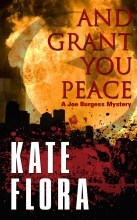
The series didn’t end there because my readers weren’t ready for Joe Burgess to retire. Those books were followed by Led Astray, A Child Shall Lead Them, A World of Deceit, and Such a Good Man.
Those Who Choose Evil is book nine. It opens on a cold, late fall night when a weary Burgess, eager to head home, finds himself instead at a city park.
It was a habit Burgess had developed years ago. A nocturnal one. At the end of a shift or if he needed some space with his thoughts, he’d swing by the park. Sometimes he’d stay in his truck and think. Sometimes he’d get out and walk into the park. He liked the smell of the earth, sometimes of fresh cut grass, sometimes the fall scent of decaying leaves or, in winter, the sharp bite of cold air mixed with the salty tang of the sea.
It was the place where, maybe five years ago, he’d found a young teenage hooker, naked, badly beaten, and left to die in the winter cold.
She’d survived and after some setbacks and missteps, had gone on to train as a massage therapist. Now Alana Black sometimes came to dinner with him and Chris and the kids. She thought it was hilarious that she’d gone straight and ended up with a cop for a friend.
Tonight, even though a late November frost had turned the grass silver under a full moon, tempting him to a nocturnal walk, he was too tired to bother. A bad night’s sleep and a long day at work had worn him out. He was planning to head home, where Chris would have saved a plate of dinner for him, but his truck had other ideas. When he told it to go left, it went right, rolling to a stop where he always parked when he wanted to check the park. Bad enough that his teammate Terry Kyle could read his mind. Now his vehicle was doing it?
Swearing, he grabbed his flashlight—the big, bright one that could sweep the park—and stepped out into the crisp night. Moist air had gathered around streetlights in nebulous halos and the frozen grass crunched under his feet. In the distance, an occasional car up on the highway sped past but down here he was alone. After a day of constant human contact, it felt good to be alone. Maybe his truck just knew?
His back to the highway, he stood looking out into the darkness, filtering out the traffic sounds behind him and focusing on anything that might not sound right. He might be annoyed at the way the universe decided things for him, but he was pretty sure he was here for a reason. Cops had instincts. They had gut sense. Just like he sometimes believed in divine intervention, Burgess believed that his city sometimes spoke to him. Tonight it wanted him here; now he needed to know why.
If you’re interested, here’s a quick interview with me for WABI TV 5:
https://www.wabi.tv/2025/06/12/crime-fiction-true-crime-writer-discusses-two-new-stand-alone-books/
June 16, 2025
The “No Kings” Movement in 1775
Kaitlyn Dunnett/Kathy Lynn Emerson here, today sharing a lesser-known bit of Revolutionary War history.
Almost 250 years ago, in August 1775, a group of Nova Scotia men asked General George Washington to send 1000 men, four armed vessels, and eight transports to Windsor, rally local support, and continue on to capture the port of Halifax. Washington rejected the idea on the basis that Nova Scotia (which at that time included present-day New Brunswick) was too remote to hold. Anti-British feeling in the area was high, however, and in February 1776, Jonathan Eddy and fourteen companions left Canada to meet with General Washington in person and try to convince him to change his mind.
They were not successful, but after a brief return home in May, Eddy traveled to Massachusetts in search of military support. This was a logical move. Until 1820, Maine was part of Massachusetts and settlements in Eastport and Machias were relatively close to border towns like Sackville. While Eddy was away, however, 200 British soldiers were sent to Fort Cumberland, which commanded the Isthmus of Chignecto. Pro-revolution leaders were forced to flee by boat to Machias. Their families, including Eddy’s wife and daughter-in-law, were left behind. An expedition to take Fort Cumberland was being planned, but when word leaked out the British sent the Rainbow, two frigates, and an armed brig to attack Machias.

Fort Cumberland
By October, Eddy had gathered eighty men, together with supplies and ammunition, and left Boston for Chignecto. He was joined by enough local men to have a force of 180 when he laid siege to Fort Cumberland. Unfortunately, they were unable to capture the fort before reinforcements from Windsor’s Fort Edward staged a pre-dawn raid on Eddy’s camp, killing some of the rebels and routing the rest. A reward of £200 was offered for Eddy’s capture and a bounty of £100 was placed on John Allen for “exciting rebellion;” Since the British could not find Allen, whose home was seven miles from Fort Cumberland, they set fire to his house with his wife and children still inside.
Mary Allen and her five young children, including seven-month-old George Washington Allen, fled into the woods. They were near starvation and half-frozen by the time her father found them three days later. He was allowed to keep the children, but Mrs. Allen was arrested and imprisoned in Halifax. In June 1777, Allen wrote that many others had been forced from their homes in Cumberland County by “the severe and rigid mandates of the British Tyrant, whose subjects are persecuting the unhappy sufferers with unrelenting malice and fury.” Women with pro-revolutionary sympathies were “kicked when met in the street” and taunted with shouts of “Dam’d rebel bitches and whores.” Allen’s wife, still in custody, repeatedly refused to answer questions about her husband’s whereabouts, saying only that he had gone to “a free country.” When she was finally released, she joined him in Machias.

Jonathan Eddy’s wife and three children were unable to leave Nova Scotia until a special truce was granted in September 1777. At that time there were “a considerable number in the woods . . . waiting for relief from the straits.” Many of those people settled in Maine after the war.
One of the revolutionaries who remained in Nova Scotia, providing information and supplies to his friends in New England, where he had lived until 1766, was Moses Blaisdell. In 1783, he was outlawed for “over acts” against Nova Scotia and he and his extended family, including his son-in-law, Samuel Emerson, were forced to flee. Traveling in small boats, they sailed down the coast at night to avoid capture by British soldiers. They ended up settling on Verona Island in the Penobscot River.
Although Nova Scotians did not succeed in becoming our fourteenth state, a great many of them did end up settling in this country, particularly in Maine. Jonathan Eddy founded Eddington. John Allen settled on Treat’s Island in Passamaquoddy Bay, and Moses Blaisdell’s sons relocated in Thomason, Bucksport, and Orland. One of Samuel and Naomi Blaisdell Emerson’s descendants ended up in Bangor . . . which is why my husband came to be born there.

Kathy Lynn Emerson/Kaitlyn Dunnett has had sixty-four books traditionally published and has self published others. She won the Agatha Award and was an Anthony and Macavity finalist for best mystery nonfiction of 2008 for How to Write Killer Historical Mysteries and was an Agatha Award finalist in 2015 in the best mystery short story category. In 2023 she won the Lea Wait Award for “excellence and achievement” from the Maine Writers and Publishers Alliance. She was the Malice Domestic Guest of Honor in 2014. She is currently working on creating new editions of her backlist titles. Her website is www.KathyLynnEmerson.com.
Lea Wait's Blog
- Lea Wait's profile
- 508 followers



